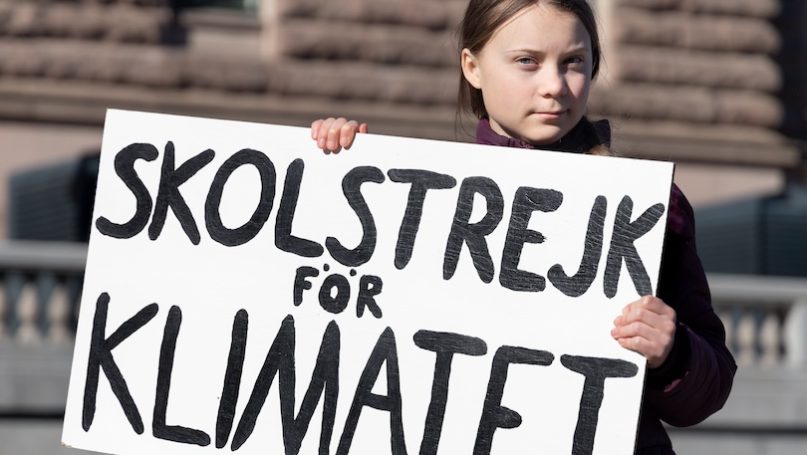
This case study is an excerpt from McGlinchey, Stephen. 2022. Foundations of International Relations (London: Bloomsbury).
The role of individuals in international relations is probably most often talked about in the global debate about climate and environmental issues. Within this area, there is one particular case that comes to mind: Greta Thunberg. The Swedish climate change activist, a 15-year old high school student at the time, started her protest in the most low-tech kind of way: by sitting in front of the Swedish Parliament during school hours, holding up a handmade sign ‘School strike for the climate’. She did, however, also upload a photo of herself in this very situation to her Instagram and Twitter accounts. Thunberg’s protest rapidly gained attention as high-profile activists and stakeholders re-tweeted her photo and continued to re-post her daily updates on Instagram. On day three of her protest, Thunberg was excited to see more than 30 people join her in front of the parliament. Two months later, her #FridaysForFuture hashtag had gone viral and student-led protests of the same kind had spread across the world.
After initially writing her posts in Swedish, she switched to English, presumably to facilitate the spread of her political message. She has since also engaged in some highly visible acts of protest including her crossing of the Atlantic on a sailing boat (rather than a plane, making a point about the harm caused by fossil fuels), and speeches at the United Nations Climate Action Summit and the World Economic Forum in Davos. Today, Thunberg is a celebrity activist with millions of followers on social media. Beyond (but importantly through her visibility on) social media, her cause was, among others, officially endorsed by the Club of Rome (a humanitarian and environmentalist NGO), the Scientists for Future (a collective of academic climate change experts), and by Science and Nature, two of the most prominent academic journals.
Thunberg’s rise to global fame and visibility has come at a time when the general awareness of the consequences of climate change is higher than before, particularly amongst younger generations. Born out of dissatisfaction with the lack of progress in global environmental matters following the UN Conference of 1992 in Rio on the Environment and Development, the 2000s saw the establishment of a more mainstream environmentalist global narrative. 2001 saw the creation of the ‘Global Greens’, an international network of political parties, movements, partner networks and non-governmental organisations advocate the ‘Global Greens Charter’. Thunberg has been able to reinvigorate this global debate and shown that more than ever before, by way of advanced and increasingly accessible information technology, there is the scope and potential for activism.
Localised ‘grass-roots’ activism – as with Thunberg’s – can quickly morph into a wider political movement, sparked by individuals whose actions and the political messages they convey cannot only penetrate local and national societies but also transcend borders and even achieve global impact.
Furthermore, scholars have warned of the modernist and somewhat simplistic assumption that this technology has a democratising effect in its own right. Morozov (2009) warned against the misguided belief that all activity online was well intentioned, warning of a darker side of internet freedom and the way it can equally empower illiberal forces. Also, social media may bear the potential for individuals to get more involved but many forms of this kind of participation are more inspired by ‘slacker activism/slacktivism’ with little material impact on the cause (Dennis 2018). In these cases there is a perception that simply ‘liking’ something on social media or signing a petition is sufficient and/or allows an individual to appear to be part of a movement. Yet, in reality such actions (by themselves) are ‘virtually’ worthless. So, what we are looking at with this phenomenon is more of a relatively novel range of possibilities for self-expression, activism and mobilisation, but not without their caveats and limitations.
A related concept is the one of celebrity activism that finds itself enabled by internet-based communication technology (see Farrell 2018). On the one hand, this includes established celebrities that make use of digital media to advocate a cause, such as in the case of the #BringBackOurGirls campaign led by Western female celebrities like Michelle Obama, Cara Delevigne, Julia Roberts and Keira Knightley to put pressure on the Nigerian government and push for Western intervention to free hundreds of girls that had been kidnapped by the terrorist group Boko Haram (see Hopkins and Louw 2019).
On the other hand, we also see this kind of activism by self-promoted ‘influencers’, who make use of their digital platforms to support and mobilise support for transboundary issues (see Lewis 2019). In these cases the results are mixed, but can sometimes have a real world effect. Not everyone who voices political opinions online will be a Greta Thunberg, but her example shows that it is possible that any individual could find their voice amplified if they were sufficiently inspirational, motivated and fortunate.
If International Relations was still stuck in its state and system level fascinations, scholarship would miss – or dismiss – much of the impact of this important level of analysis. Greta Thunberg’s example is a testament to the importance of the rise of the individual and the impact one person’s voice can have in the vastness of the global system.
Further Reading on E-International Relations
- Donald Trump and Climate Denial
- Student Feature – Theory in Action: Global South Perspectives on Development
- The Death Penalty and Human Rights Activism
- Student Feature – Theory in Action: Global Justice and Climate Change
- Environment and Climate
- Student Feature – Theory in Action: Green Theory and Climate Change